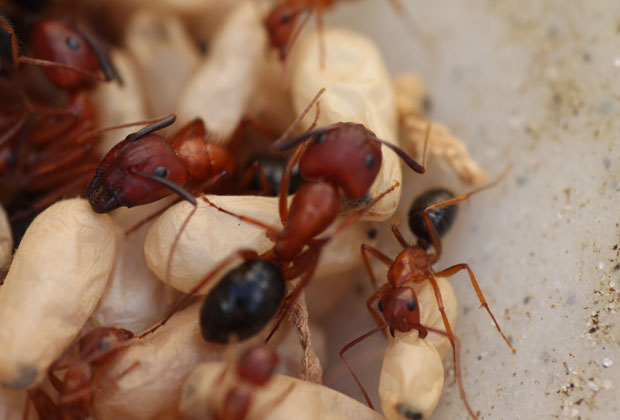In the United States, of the 22 harvester ant species found, the most common types of harvester ants live west of the Mississippi, except the Florida harvester ant, which can be found in the Mid-Atlantic states as well as in Florida. Western species include California harvester ants, Western harvester ants, red harvester ants and black harvester ants.
Typical harvester ant colonies consist of workers, winged reproductives and a single queen. Reproductive adults swarm, mate and form new colonies between June and October, usually swarming in the afternoon after a rain shower. Unusually long-lived, the oldest harvester ant colony on record lasted at least 19 years, while some species’ queens live as long as 17 years.
Always on the job, harvester ants moonlight as ant farm celebrities. According to AntsAlive.com, “Western Harvester ants are the best ants for digging tunnels and working under observation.” Other ant species reportedly don’t do as well under observation. In a Science News article, Florida State University professor, Walter Tschinkel praised harvester ants’ nest-building abilities, saying that Florida harvester ants “make a nest that is truly beautiful in its architecture.”
Tschinkel went on to say that for unknown reasons, Florida harvester ants, “abandon their lovely nests about once a year and dig new ones,” moving only two to six meters away from their old homes.
Entrances to the harvester ant’s elaborate nests are marked by moderate to large mounds of dirt, with the area surrounding the mound stripped of all vegetation to prevent shading and bits of burnt pine needles placed around the entrance. Typically, harvester ants stay below ground during the hottest parts of the day and need all the solar power they can muster to stay warm underground.
While harvester ants do not usually infest homes, they build their nests near homes, where they destroy grass and other vegetation surrounding their nests. Besides trashing lawns, golf courses and playgrounds with their unsightly mounds, harvester ants pose a threat to humans and pets, as they will sting, if provoked, and their venom is one of the most powerful insect venoms known to science.


